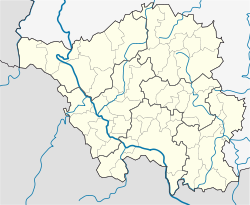You can help expand this article with text translated from the corresponding article in German. (October 2018)Click [show] for important translation instructions.
|
Abtei Fraulautern | |
 Fraulautern Abbey, 1865, with in the foreground the new railway line on the Saar, on the left the abbey mill (Klostermühle), in the middle the Baroque abbey church, on the right the gatehouse | |
 | |
| Monastery information | |
|---|---|
| Order | Augustinian canonesses |
| Established | 12th century |
| Dedicated to | St. Augustine |
| Site | |
| Location | Saarlouis in Saarland, Germany |
| Coordinates | 49°19′23″N6°45′47″E / 49.32306°N 6.76306°E |

Fraulautern Abbey (German : Abtei Fraulautern; Latin : Abbatia in Lutrea) was a community of Augustinian canonesses of the nobility, founded in the 12th century; it was suppressed in the 1790s during the French Revolution.


